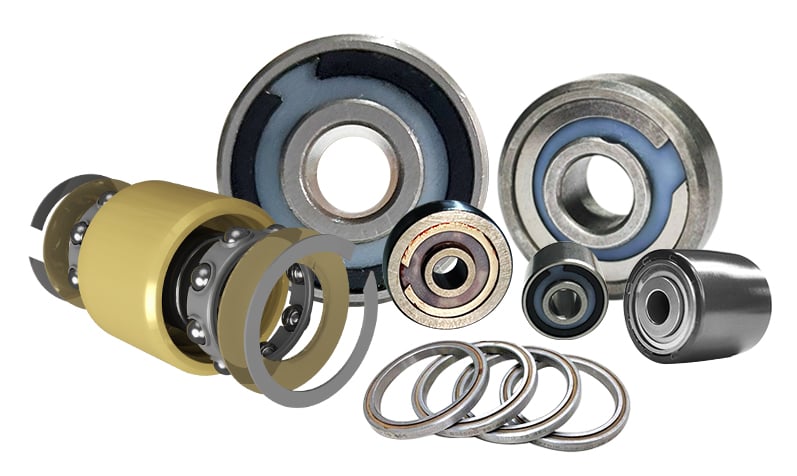Aerospace Bearings: Focus on Airframe Control Ball Bearings
CONTENTS
In the demanding fields of aerospace and aviation, the importance of reliable Aerospace Bearings and Aviation Bearings can't be overstated. Among these, Airframe Control Ball Bearings are specially engineered to withstand extreme conditions like temperature changes and high pressure. This blog will focus on the vital role these specialized bearings, underscoring their significance in ensuring aircraft safety and performance.

Understanding Airframe Control Ball Bearings
Airframe Control Ball Bearings are engineered to offer precise control and reliability in managing an aircraft's stability and attitude. Their key contributions can be summarized as follows:
- Attitude Control: These bearings help maintain an aircraft's desired orientation—pitch, roll, and yaw—ensuring a stable flight.
- Maneuverability: Vital for executing precise turns, climbs, and descents, these bearings make the aircraft agile and responsive.
- Safety: Their reliable performance directly impacts the overall safety of the flight by preventing unintended deviations.
- Structural Integrity: These bearings contribute to the aircraft's durability by facilitating controlled movement without compromising structural strength.
- Efficient Inputs: They translate pilot inputs into accurate aircraft movements, offering fine-grained control.
- Performance: Well-designed bearings enhance the overall flight performance, meeting diverse operational requirements.
- Flight Control Systems: They are integral to the aircraft's control systems, interacting with actuators and sensors for smooth operation.
- Versatility: Used in various control surfaces like ailerons and rudders, they ensure the aircraft accurately responds to pilot commands.
Diving Deep: Types of Airframe Control Ball Bearings
Based on Structure
- single-row: Single row bearings are the most commonly used type and are suitable for applications that require radial loads and can accommodate axial loads in one direction.
- double-row: Double row bearings are used for applications that require higher radial and axial loads, and they have a higher load capacity than single row bearings.
Based on Load-carrying Capacity
- Extra light duty
- Light and heavy duty
- Intermediate duty
- heavy duty
- Extra wide variants
Table 1 presents some series of airframe control ball bearings, categorized by their respective load capacities.
Table 1 Series of Airframe Control Ball Bearings by Load Capacity
|
Structure |
Load Capacity |
Series |
|
Single Row |
Heavy Duty |
KP- (AS27640) / MKP- |
|
Intermediate Duty |
KP-A (AS27641) / MKP-A |
|
|
Extra Light Duty |
KP--B (AS27642) |
|
|
Extra Light Duty, Precision |
MKP--B (AS27642) |
|
|
Extra Light Duty, Self-aligning |
KP--BS (AS27648) / MKP--BS |
|
|
Self-aligning, Light and Heavy Duty |
KSP-, KSP-A (AS27645) / MKSP-, MKSP-A |
|
|
Extra Light Duty, Anti-friction |
B500DD (AS27646) / MB500DD (AS21428) |
|
|
Extra Light Duty, Torque Tube |
||
|
Intermediate Duty, Stainless Steel |
SSW-AK (AS27649) |
|
|
Double Row |
Heavy Duty, Self-aligning |
DSP- (AS27643) / MDSP- |
|
Heavy Duty |
DPP- (AS27644) / MDPP- |
|
|
Rigid Type |
||
|
Extra Wide, Intermediate Duty |
DW-K, DW- (AS27647) |
|
|
Extra Wide, Intermediate Duty |
GDW-K, GDW-(AS27647) |
|
|
Extra Wide, Intermediate Duty, Precision |
Based on Configuration
Airframe control ball bearings feature two unique configurations. Each is engineered to meet aerospace's stringent demands for precision and reliability.
Torque Tube
These bearings excel in rotational torque control and alignment, commonly utilized in flap and aileron control systems.
Track Roller
Designed for linear motion, these bearings support heavy radial loads and are often found in landing gear assemblies.
Table 2 presents some series of airframe control ball bearings, categorized by unique shapes and configurations.
Table 2 Series of Airframe Control Ball Bearings by Configuration
|
Structure |
Configuration |
Series |
|
Single Row |
Track Roller |
|
|
Double Row |
Airframe, Torque Tube |
|
|
Track Roller |
||
|
Single and Double Row |
Pulley Type |
|
|
Single and Double Row |
Guide Roller |
Benefits of Airframe Control Ball Bearings
Airframe Control Ball Bearings are specialized bearings crucial for aircraft control systems. They facilitate precise, low-friction movement for key control surfaces such as ailerons and rudders.
Key Features:
- High Precision: Essential for accurate aircraft control and stability.
- Low Friction: Minimizes wear and boosts efficiency.
- High Load Capacity: Handles variable flight forces.
- Corrosion Resistance: Built for harsh aerospace environments.
- Lightweight: Engineered for optimal weight without sacrificing integrity.
- Lubrication and Sealing: Designed for smooth operation and long-term reliability.
Materials in the Spotlight: Make-up of Airframe Control Ball Bearings
Airframe Control Ball Bearings are mainly manufactured from the following materials to meet the demanding conditions of aerospace applications.
- AISI 52100: Known for its high hardness and excellent wear resistance, this alloy steel is commonly used for its durability.
- AISI 440C: A stainless steel variant that offers good hardness combined with corrosion resistance, making it suitable for more hostile environments.
Besides, there are other premium-quality steels which are chosen for specific needs, ensuring attributes like extreme temperature resistance or special load-bearing capacity.
Protective Measures of Airframe Control Ball Bearings
Airframe Control Ball Bearings employ various protective measures to ensure longevity and reliability, particularly concerning corrosion resistance.
PTFE Shields & Seals
Polytetrafluoroethylene (PTFE) shields and seals are frequently used due to their high tolerance for hydraulic fluids, greases, and solvents. PTFE is not only resistant to chemical erosion but also provides excellent low-friction properties, further enhancing the bearing's performance.
Corrosion-Resistant Platings
- Cadmium Plating: Provides robust protection against corrosion, particularly in high-moisture environments.
- Zinc Nickel Plating: Offers strong corrosion resistance and is suitable for high-temperature conditions.
These protective measures contribute to the overall durability and reliability of airframe control ball bearings in various aerospace applications.
Precision vs. Standard Bearings
Airframe control ball bearings are available in two distinct series—Standard and Precision. Each caters to specific requirements within aerospace applications.
- Standard Series: Meets most aerospace needs, offering a balance of performance and cost.
- Precision Series: Ideal for high-precision requirements, crafted with tighter tolerances.
- Dual Options: Some models come in both Standard and Precision versions, providing flexibility to choose based on application needs.
Precision bearings are essential in aerospace for high-accuracy tasks where small errors can impact safety. Standard airframe control ball bearings suffice for less critical applications. The choice between the two depends on the specific aerospace needs.
Conclusion
This blog has explored the vital role of airframe control ball bearings in aerospace and aviation. These bearings endure extreme conditions and come in various types and materials to meet industry demands. The choice between Standard and Precision bearings hinges on your specific aerospace requirements. Choose wisely based on your application needs. LILY Bearing offers certified Aerospace and Aviation Bearings to meet these stringent standards. Trust LILY for safe, reliable, and high-performing solutions.
Keep Learning








